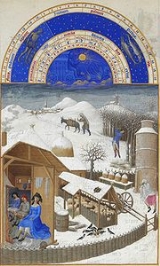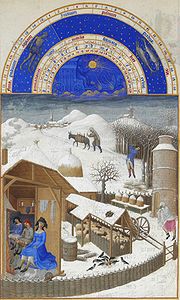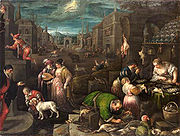
February
Encyclopedia
February is the second month
of the year
in the Julian
and Gregorian calendar
s. It is the shortest month and the only month with fewer than 30 day
s. The month has 28 days in common years and 29 days in leap year
s. Also known as "Hunter's Month".
In the Southern Hemisphere
, February is the seasonal equivalent of August
in the Northern Hemisphere
.
February starts on the same day of the week as March and November in common years, and on the same day of the week as August in leap years. February ends on the same day of the week as October every year and January in common years only. In leap years, it is the only month that ends on the same weekday it begins.


 February was named after the Latin term februum, which means purification, via the purification ritual Februa
February was named after the Latin term februum, which means purification, via the purification ritual Februa
held on February 15 (full moon) in the old lunar Roman calendar
. January and February were the last two months to be added to the Roman calendar, since the Romans originally considered winter a monthless period. They were added by Numa Pompilius
about 713 BC. February remained the last month of the calendar year until the time of the decemvirs (c. 450 BC), when it became the second month. At certain intervals February was truncated to 23 or 24 days; and a 27-day intercalary month, Intercalaris
, was inserted immediately after February to realign the year with the season
s.
Under the reforms that instituted the Julian calendar
, Intercalaris was abolished, leap years occurred regularly every fourth year, and in leap years February gained a 29th day. Thereafter, it remained the second month of the calendar year, meaning the order that months are displayed (January, February, March, ..., December) within a year-at-a-glance calendar. Even during the Middle Ages, when the numbered Anno Domini
year began on March 25 or December 25, the second month was February whenever all twelve months were displayed in order. The Gregorian calendar
reforms made slight changes to the system for determining which years were leap years and thus contained a 29-day February.
Historical names for February include the Old English
terms Solmonath (mud month) and Kale-monath (named for cabbage
) as well as Charlemagne
's designation Hornung. In Finnish
, the month is called helmikuu, meaning "month of the pearl"; when snow melts on tree branches, it forms droplets, and as these freeze again, they are like pearls of ice. In Polish
and Ukrainian
, respectively, the month is called luty or лютий, meaning the month of ice or hard frost.
effect whereby having two "r"s close to each other causes one to change for ease of pronunciation. The Scots language
names for the month are Feberwary and Februar, the latter usually pronounced with a long "ay" in the first syllable.
Having only 28 days in common years, it is the only month of the year that can pass without a single full moon. It is also the only month of the calendar that once every six years and twice every 11 years, will have only four full 7-day week
s. Where the first day of the month starts on a Monday and the last day ends on a Sunday, this was observed in 2010 and can be traced back 11 years to 1999, 6 years back to 1993, 11 years back to 1982, 11 years back to 1971 and 6 years back to 1965; and so on twice 11 years consecutively and once six years either forward into the future or back into the past. This works unless the pattern is broken by a skipped leap year, but no leap year has been skipped since 1900 and no others will be skipped until 2100. (Years that are evenly divisible by 100 are not leap years, unless they are also evenly divisible by 400, in which case they are leap years.) A year of this kind would be a common year starting on Friday
. It cannot happen in a leap year.

Month
A month is a unit of time, used with calendars, which was first used and invented in Mesopotamia, as a natural period related to the motion of the Moon; month and Moon are cognates. The traditional concept arose with the cycle of moon phases; such months are synodic months and last approximately...
of the year
Year
A year is the orbital period of the Earth moving around the Sun. For an observer on Earth, this corresponds to the period it takes the Sun to complete one course throughout the zodiac along the ecliptic....
in the Julian
Julian calendar
The Julian calendar began in 45 BC as a reform of the Roman calendar by Julius Caesar. It was chosen after consultation with the astronomer Sosigenes of Alexandria and was probably designed to approximate the tropical year .The Julian calendar has a regular year of 365 days divided into 12 months...
and Gregorian calendar
Gregorian calendar
The Gregorian calendar, also known as the Western calendar, or Christian calendar, is the internationally accepted civil calendar. It was introduced by Pope Gregory XIII, after whom the calendar was named, by a decree signed on 24 February 1582, a papal bull known by its opening words Inter...
s. It is the shortest month and the only month with fewer than 30 day
Day
A day is a unit of time, commonly defined as an interval equal to 24 hours. It also can mean that portion of the full day during which a location is illuminated by the light of the sun...
s. The month has 28 days in common years and 29 days in leap year
Leap year
A leap year is a year containing one extra day in order to keep the calendar year synchronized with the astronomical or seasonal year...
s. Also known as "Hunter's Month".
In the Southern Hemisphere
Southern Hemisphere
The Southern Hemisphere is the part of Earth that lies south of the equator. The word hemisphere literally means 'half ball' or "half sphere"...
, February is the seasonal equivalent of August
August
August is the eighth month of the year in the Julian and Gregorian Calendars and one of seven months with a length of 31 days.This month was originally named Sextilis in Latin, because it was the sixth month in the original ten-month Roman calendar under Romulus in 753 BC, when March was the first...
in the Northern Hemisphere
Northern Hemisphere
The Northern Hemisphere is the half of a planet that is north of its equator—the word hemisphere literally means “half sphere”. It is also that half of the celestial sphere north of the celestial equator...
.
February starts on the same day of the week as March and November in common years, and on the same day of the week as August in leap years. February ends on the same day of the week as October every year and January in common years only. In leap years, it is the only month that ends on the same weekday it begins.
History



Februa
Februa, also Februatio, was the Roman festival of ritual purification, later incorporated into Lupercalia. The festival, which is basically one of Spring washing or cleaning is old, and possibly of Sabine origin...
held on February 15 (full moon) in the old lunar Roman calendar
Roman calendar
The Roman calendar changed its form several times in the time between the founding of Rome and the fall of the Roman Empire. This article generally discusses the early Roman or pre-Julian calendars...
. January and February were the last two months to be added to the Roman calendar, since the Romans originally considered winter a monthless period. They were added by Numa Pompilius
Numa Pompilius
Numa Pompilius was the legendary second king of Rome, succeeding Romulus. What tales are descended to us about him come from Valerius Antias, an author from the early part of the 1st century BC known through limited mentions of later authors , Dionysius of Halicarnassus circa 60BC-...
about 713 BC. February remained the last month of the calendar year until the time of the decemvirs (c. 450 BC), when it became the second month. At certain intervals February was truncated to 23 or 24 days; and a 27-day intercalary month, Intercalaris
Mercedonius
Mercedonius, also known as Intercalaris, was the intercalary month added in leap years of the Roman calendar. The resulting year was either 377 or 378 days long. The exact mechanism by which this was done is not clearly specified in ancient sources. Modern scholarship holds that Februarius was...
, was inserted immediately after February to realign the year with the season
Season
A season is a division of the year, marked by changes in weather, ecology, and hours of daylight.Seasons result from the yearly revolution of the Earth around the Sun and the tilt of the Earth's axis relative to the plane of revolution...
s.
Under the reforms that instituted the Julian calendar
Julian calendar
The Julian calendar began in 45 BC as a reform of the Roman calendar by Julius Caesar. It was chosen after consultation with the astronomer Sosigenes of Alexandria and was probably designed to approximate the tropical year .The Julian calendar has a regular year of 365 days divided into 12 months...
, Intercalaris was abolished, leap years occurred regularly every fourth year, and in leap years February gained a 29th day. Thereafter, it remained the second month of the calendar year, meaning the order that months are displayed (January, February, March, ..., December) within a year-at-a-glance calendar. Even during the Middle Ages, when the numbered Anno Domini
Anno Domini
and Before Christ are designations used to label or number years used with the Julian and Gregorian calendars....
year began on March 25 or December 25, the second month was February whenever all twelve months were displayed in order. The Gregorian calendar
Gregorian calendar
The Gregorian calendar, also known as the Western calendar, or Christian calendar, is the internationally accepted civil calendar. It was introduced by Pope Gregory XIII, after whom the calendar was named, by a decree signed on 24 February 1582, a papal bull known by its opening words Inter...
reforms made slight changes to the system for determining which years were leap years and thus contained a 29-day February.
Historical names for February include the Old English
Old English language
Old English or Anglo-Saxon is an early form of the English language that was spoken and written by the Anglo-Saxons and their descendants in parts of what are now England and southeastern Scotland between at least the mid-5th century and the mid-12th century...
terms Solmonath (mud month) and Kale-monath (named for cabbage
Cabbage
Cabbage is a popular cultivar of the species Brassica oleracea Linne of the Family Brassicaceae and is a leafy green vegetable...
) as well as Charlemagne
Charlemagne
Charlemagne was King of the Franks from 768 and Emperor of the Romans from 800 to his death in 814. He expanded the Frankish kingdom into an empire that incorporated much of Western and Central Europe. During his reign, he conquered Italy and was crowned by Pope Leo III on 25 December 800...
's designation Hornung. In Finnish
Finnish language
Finnish is the language spoken by the majority of the population in Finland Primarily for use by restaurant menus and by ethnic Finns outside Finland. It is one of the two official languages of Finland and an official minority language in Sweden. In Sweden, both standard Finnish and Meänkieli, a...
, the month is called helmikuu, meaning "month of the pearl"; when snow melts on tree branches, it forms droplets, and as these freeze again, they are like pearls of ice. In Polish
Polish language
Polish is a language of the Lechitic subgroup of West Slavic languages, used throughout Poland and by Polish minorities in other countries...
and Ukrainian
Ukrainian language
Ukrainian is a language of the East Slavic subgroup of the Slavic languages. It is the official state language of Ukraine. Written Ukrainian uses a variant of the Cyrillic alphabet....
, respectively, the month is called luty or лютий, meaning the month of ice or hard frost.
Pronunciation
Many people pronounce the 'ru' of "February" juː you rather than /ruː/ roo, as if it were spelled "Feb-u-ary". This comes about by analogy with "January" (which ends in "-uary" but not "-ruary"); as well as by a dissimilationDissimilation
In phonology, particularly within historical linguistics, dissimilation is a phenomenon whereby similar consonant or vowel sounds in a word become less similar...
effect whereby having two "r"s close to each other causes one to change for ease of pronunciation. The Scots language
Scots language
Scots is the Germanic language variety spoken in Lowland Scotland and parts of Ulster . It is sometimes called Lowland Scots to distinguish it from Scottish Gaelic, the Celtic language variety spoken in most of the western Highlands and in the Hebrides.Since there are no universally accepted...
names for the month are Feberwary and Februar, the latter usually pronounced with a long "ay" in the first syllable.
Patterns
February starts on the same day of the week as both March and November in common years, and August in leap years.Having only 28 days in common years, it is the only month of the year that can pass without a single full moon. It is also the only month of the calendar that once every six years and twice every 11 years, will have only four full 7-day week
Week
A week is a time unit equal to seven days.The English word week continues an Old English wice, ultimately from a Common Germanic , from a root "turn, move, change"...
s. Where the first day of the month starts on a Monday and the last day ends on a Sunday, this was observed in 2010 and can be traced back 11 years to 1999, 6 years back to 1993, 11 years back to 1982, 11 years back to 1971 and 6 years back to 1965; and so on twice 11 years consecutively and once six years either forward into the future or back into the past. This works unless the pattern is broken by a skipped leap year, but no leap year has been skipped since 1900 and no others will be skipped until 2100. (Years that are evenly divisible by 100 are not leap years, unless they are also evenly divisible by 400, in which case they are leap years.) A year of this kind would be a common year starting on Friday
Common year starting on Friday
This is the calendar for any common year starting on Friday, January 1 . Examples: Gregorian years 1993, 1999, 2010 and 2021or Julian years 1910 and 1899 ....
. It cannot happen in a leap year.
Events in February
- Black History MonthBlack History MonthBlack History Month is an observance of the history of the African diaspora in a number of countries outside of Africa. Since 1976, it is observed annually in the United States and Canada in February, while in the United Kingdom it is observed in October...
(Canada and United States) - LGBT History MonthLGBT History MonthLGBT History Month is a month-long annual observance of lesbian, gay, bisexual and transgender history, and the history of the gay rights and related civil rights movements. It is observed during October in the United States, to include National Coming Out Day on October 11...
(United Kingdom) - National Bird-Feeding MonthNational Bird-Feeding MonthFebruary is National Bird-Feeding Month. This celebratory month was created to educate the public on the wild bird feeding and watching hobby. Because of National Bird-Feeding Month, February has become the month most recognized with wild bird feeding promotions and activities...
- Parent Leadership Month
- Aboliltion of Slavery in Mauritius:February 1
- St Brigid’s DayBrigid of KildareSaint Brigit of Kildare, or Brigit of Ireland , nicknamed Mary of the Gael is one of Ireland's patron saints along with Saints Patrick and Columba...
: February 1, Ireland - Groundhog DayGroundhog DayGroundhog Day is a holiday celebrated on February 2 in the United States and Canada. According to folklore, if it is cloudy when a groundhog emerges from its burrow on this day, it will leave the burrow, signifying that winter-like weather will soon end...
: February 2, United States and Canada - ImbolcImbolcImbolc , or St Brigid’s Day , is an Irish festival marking the beginning of spring. Most commonly it is celebrated on 1 or 2 February in the northern hemisphere and 1 August in the southern hemisphere...
: February 2 - Chinese new YearChinese New YearChinese New Year – often called Chinese Lunar New Year although it actually is lunisolar – is the most important of the traditional Chinese holidays. It is an all East and South-East-Asia celebration...
: February 3rd - Independence of Sri Lanka: February 4
- 1917 Constitution of Mexico: February 5
- Waitangi DayWaitangi DayWaitangi Day commemorates a significant day in the history of New Zealand. It is a public holiday held each year on 6 February to celebrate the signing of the Treaty of Waitangi, New Zealand's founding document, on that date in 1840.-History:...
in New Zealand: February 6 - Slovenian Cultural Holiday: February 8
- National Foundation DayNational Foundation Dayis a national holiday in Japan celebrated annually on February 11. On this day, Japanese celebrate the founding of the nation and the imperial line by its legendary first emperor, Jimmu, who according to legend established his capital in Yamato in 660 BC....
in Japan: February 11 - Abraham LincolnAbraham LincolnAbraham Lincoln was the 16th President of the United States, serving from March 1861 until his assassination in April 1865. He successfully led his country through a great constitutional, military and moral crisis – the American Civil War – preserving the Union, while ending slavery, and...
's birthday: February 12, United States - Valentine's DayValentine's DaySaint Valentine's Day, commonly shortened to Valentine's Day, is an annual commemoration held on February 14 celebrating love and affection between intimate companions. The day is named after one or more early Christian martyrs named Saint Valentine, and was established by Pope Gelasius I in 496...
: February 14 - Saint Valentine's Day Massacre: An infamous mafia attack. February 14
- Flag DayFlag DayA flag day is a flag-related holiday—either a day designated for flying a certain flag , or a day set aside to celebrate a historical event such as a nation's adoption of its flag....
of Canada: February 15 - KosovoKosovoKosovo is a region in southeastern Europe. Part of the Ottoman Empire for more than five centuries, later the Autonomous Province of Kosovo and Metohija within Serbia...
's Independence Day: February 17 - Presidents Day (United States, third Monday)
- International Mother Language DayInternational Mother Language DayInternational Mother Language Day is an observance held annually on 21 February worldwide to promote awareness of linguistic and cultural diversity and multilingualism. It was first announced by UNESCO on 17 November 1999...
: February 21 - Independence DayIndependence DayAn Independence Day is an annual event commemorating the anniversary of a nation's assumption of independent statehood, usually after ceasing to be a colony or part of another nation or state, and more rarely after the end of a military occupation...
in Saint Lucia: February 22 - George WashingtonGeorge WashingtonGeorge Washington was the dominant military and political leader of the new United States of America from 1775 to 1799. He led the American victory over Great Britain in the American Revolutionary War as commander-in-chief of the Continental Army from 1775 to 1783, and presided over the writing of...
's birthday: February 22, United States (often coincides with President's Day, see above) - Flag DayFlag DayA flag day is a flag-related holiday—either a day designated for flying a certain flag , or a day set aside to celebrate a historical event such as a nation's adoption of its flag....
of MexicoMexicoThe United Mexican States , commonly known as Mexico , is a federal constitutional republic in North America. It is bordered on the north by the United States; on the south and west by the Pacific Ocean; on the southeast by Guatemala, Belize, and the Caribbean Sea; and on the east by the Gulf of...
: February 24 - Independence DayIndependence DayAn Independence Day is an annual event commemorating the anniversary of a nation's assumption of independent statehood, usually after ceasing to be a colony or part of another nation or state, and more rarely after the end of a military occupation...
in Estonia: February 24 - People Power Revolution (PhilippinesPhilippinesThe Philippines , officially known as the Republic of the Philippines , is a country in Southeast Asia in the western Pacific Ocean. To its north across the Luzon Strait lies Taiwan. West across the South China Sea sits Vietnam...
) February 25 - Liberation Day (KuwaitKuwaitThe State of Kuwait is a sovereign Arab state situated in the north-east of the Arabian Peninsula in Western Asia. It is bordered by Saudi Arabia to the south at Khafji, and Iraq to the north at Basra. It lies on the north-western shore of the Persian Gulf. The name Kuwait is derived from the...
) February 26 - Dominican RepublicDominican RepublicThe Dominican Republic is a nation on the island of La Hispaniola, part of the Greater Antilles archipelago in the Caribbean region. The western third of the island is occupied by the nation of Haiti, making Hispaniola one of two Caribbean islands that are shared by two countries...
Independence: February 27 - Leap Day: February 29 (Every four years, with some exceptions)
- National Day of the Sun (in Argentina)
- National Wear Red Day (in the US and the UK)
February symbols

- Its birth flower is the violet (Viola (plant)) and the common primrose (Primula vulgarisPrimula vulgarisPrimula vulgaris is a species of Primula native to western and southern Europe , northwest Africa , and southwest Asia...
). - Its birthstone is the amethystAmethystAmethyst is a violet variety of quartz often used in jewelry. The name comes from the Ancient Greek ἀ a- and μέθυστος methustos , a reference to the belief that the stone protected its owner from drunkenness; the ancient Greeks and Romans wore amethyst and made drinking vessels of it in the belief...
. It symbolizes piety, humility, spiritual wisdom, and sincerity.
See also
- February 29
- February 30
- February 31
- List of historical anniversaries
Further reading
- Anthony Aveni, "February's Holidays: Prediction, Purification, and Passionate Pursuit," The Book of the Year: A Brief History of Our Seasonal Holidays (Oxford: Oxford University Press, 2003), 29–46.

